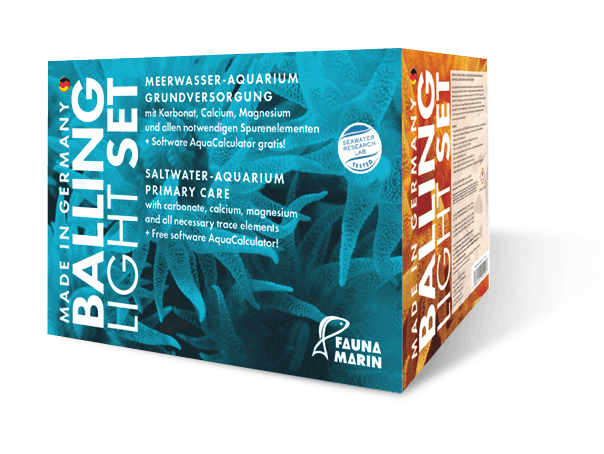Fluor
Fluorid
Fluor is a highly reactive element and therefore only occurs in seawater as fluoride. As another halogens, it also plays a very important role in reef aquaria. In relation to iodine, fluorine should be present about 25 times higher (see relation values).
Fluorine is an element whose concentration cannot be detected by ICP analysis. Due to the great importance of this element, however, we have purchased special equipment for its analysis.
What is this:
Fluor is present in seawater as fluoride. This element cannot be detected by ICP analysis and must be measured separately by IC/ISE HSA. Fluorine is an essential element for corals. In addition to its inhibiting effect on bacteria and algae, it is important for growth of corals and the defence against parasites. Fluorine also has an effect on the blue colouration of many corals.
Problems:
A too low fluorine concentration shows itself in dull tissue, reduced growth, colourless growth peaks or growth edges in foliaceous growing corals (e.g. Montipora species) and partial light sensitivity. Furthermore, the animals become more susceptible to parasitic infestation. The skeleton softens considerably. At a Florine level under 0,8 mg/Liter (o,26gal) some SPS corals showed slow tissue necrosis from the base.
Measures:
Regular control of the fluoride value, if necessary adjustment of the dosage. Reduction by partial water change and adjustment of the dosage.
Indicator species:
Indicator species are Acropora tenuis as well as Montipora species with blue or green colour and blue margin. When the fluorine deficiency starts, the blue colouration decreases and growth stops. If the fluorine deficiency increases, the sensitivity of corals to parasites such as AEFW (Acropora eating flatworms) and Montipora snails increases.
Value too high:
Reduction of the addition dosage, partial water change, values above 2.5 mg/l (0,26 US.liq.gal.) must be avoided at all costs, filtration via phosphate adsorber on aluminium basis, PHOS, activated carbon CarbL.
Value too low:
Dosing Elementals F, adjustment Trace 3 in the Balling Light System, Coral Vitality, reduction P04 adsorber on aluminium basis.
| Variety | Halogen |
|---|---|
| Reference value | 1,2–1,5 mg/l |
| Skill Level | Red, only for experienced aquarists |
| Source | salt, supply systems, trace element mixtures |
| Available | Elementals F, Balling Light System, Color Elements, Coral Vitality |
| Importance 1–6 | 6 |
| Detection quality | high |
| Relation values | Bromide, iodine, strontium |

Balling Light:
In the Balling Light system, the fluor is dosed as fluoride via the Trace-3 solution. Values between 1 and 1.5 mg/l are sufficiently high. For SPS tanks and strong lighting, a value around 1.5 mg/l (0,26 US.liq.gal.) is recommended. This can be set additionally via Elementals F. The dosage is calculated in relation to the iodine. Without filtering via aluminium-based adsorbers and regular partial water changes with Professional Sea Salt, the fluorine concentration in relation to iodine remains stable, and no additional dosing is required.
The fluoride concentration in the aquarium should be between 1.2–1.9 mg/l (0,26 US.liq.gal.) and thus, as mentioned above, about 25 times higher than that of the equally important iodine. Values that exceed 2.2 mg/l (0,26 US.liq.gal.) in the long term, however, cause lasting damage to corals. Please note that 2.2 mg/l (0,26 US.liq.gal.) ultimately correspond to 2200 µg/l (0,26 US.liq.gal.), i.e. a multiple of what we generally have for trace elements.
Fluor is important for the calcification and thus for the growth of the coral. It increases the bonding strength of the coral skeleton. In the skeleton itself we find a proportion of 2–4 % Fluor. This element is incorporated here as sodium fluoride and as calcium fluoride, and these high-strength compounds give the coral skeleton greater hardness. But also in the vital coral tissue we find fluor compounds which, in combination with other elements, serve as protection against parasites and inhibit bacterial infections.
Supplementing fluoride has a brightening effect, as it inhibits excessive zooxanthellae growth. Overall, fluor also has a bacterial regulating effect and is a catalyst for other elements. The reason for this is probably the high oxidative effect and toxicity of fluoride. However, too high concentrations have a damaging effect on photic synthetic enzymes and also act against bacterial films. Therefore avoid overdosing.
Azooxanthellate corals and deep water acroporids are particularly sensitive to fluoride deficiency or excessive doses. For the lovers of these corals, fluor is a particularly important element, the concentration of which should never fall below 1.2 mg/l (0,26 US.liq.gal.).
Fluoride reacts with many elements and is therefore also important for the colouration of the corals. However, this element does not promote a certain colour, but if the fluorine concentration is at natural values and adjusted to match bromine and iodine, fluorescent effects appear stronger and colour gradients are more beautiful. This especially applies to green and yellow fluorescence.
A fluor deficiency can be compensated by adjusting the dosage in the Balling Light system via Trace 3. The Elementals fluorine solution and Color Elements Red are also available as fluorine sources. Values that are too high can be reduced by partial water change and use of activated carbon as well as filtering via Fauna Marin aluminiumbased Adsorber Phos.
Tip:
Fluor must be dosed very precisely. The absorption of fluor into the skeleton depends on the level of carbonate hardness. If the carbonate hardness is too high and the fluor concentration is too high at the same time, SPS corals will cause tissue detachment. For corals of the Acropora echinata group, a well adjusted fluor value is very important. Only then do they show the wonderful white color and growth tips.